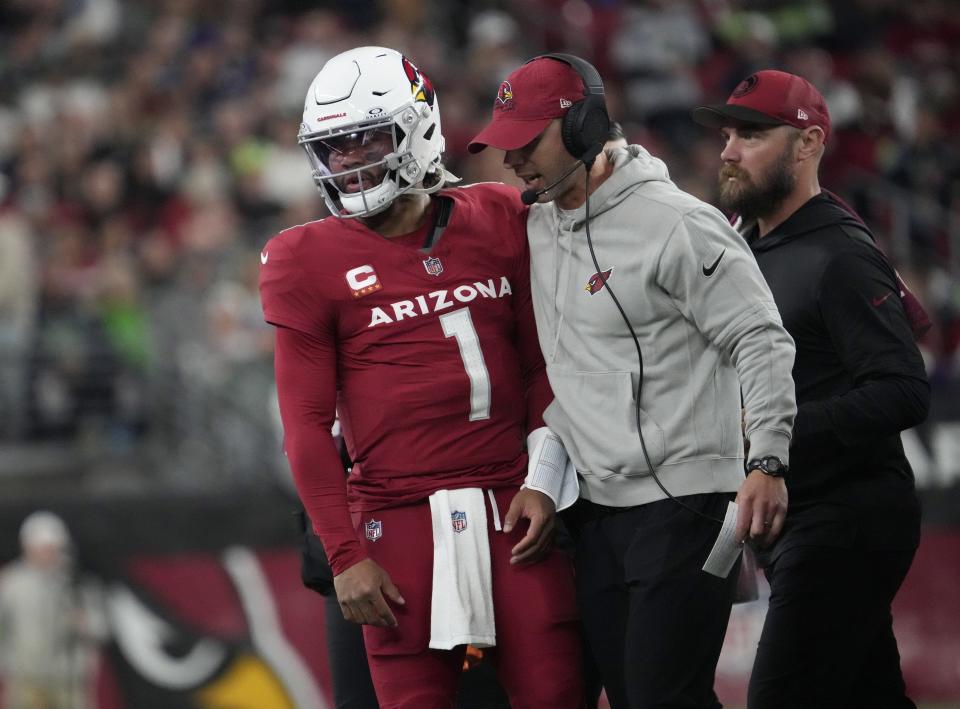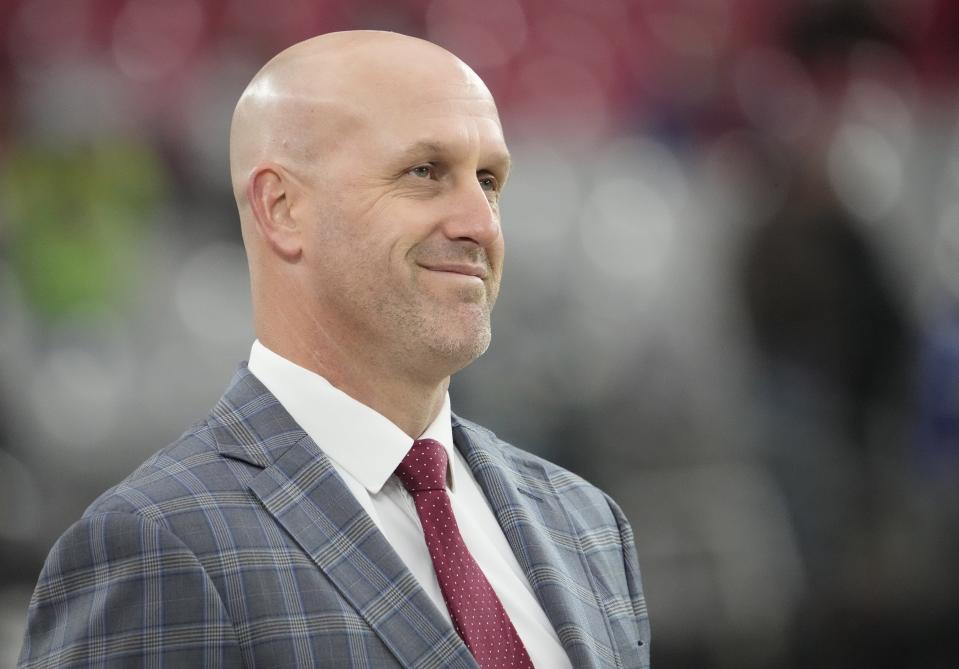Arizona Cardinals season wrap-up: What worked, what didn't and what needs to happen next
The season had just ended, the Arizona Cardinals lost for the 13th time. After falling to the rival Seahawks in a 21-20 thriller on Sunday, Kyler Murray was asked if he planned to take a couple, three weeks off to rest, rejuvenate and relax – you know, like maybe on an isolated, exotic beach somewhere.
“Nah,” the quarterback said with a deadly-serious face. “I’m working out tomorrow.”
That, in a nutshell, is what Cardinals fans should take away from Arizona’s rebuilding season under new General Manager Monti Ossenfort and first-year head coach Jonathan Gannon.
It’s not that paltry four wins. It’s the will, the want and the wait-until-next-season confidence this entire franchise believes in despite suffering through its seventh non-winning season in eight years.
They don’t plan on going quietly into this offseason without coming back with something to prove – and they made you believe it if you listened and watched closely enough in 2023 and even on Sunday when they had their chances to beat Seattle and finish with back-to-back wins.
“I’m proud of those guys,” Gannon said afterward. “They fought all year. Went through a lot of adversity and good things are on the horizon. And I told them, too. I said I’ve never been more enthused going into an offseason in my life and they’re ready to come with me.”
Time will tell how well Ossenfort, the front office and the scouting and coaching staff are able to improve the roster and immediate future of the franchise, but Arizona will have enough firepower to do it through its arsenal of draft picks and hefty salary cap space if the right moves are made.
“We laid out a hell of a foundation,” right guard Will Hernandez said. “I don’t think that our record shows how good we can be. All we have to do now is take what we did and build on it. I think it can be scary if we really put it together.”
Were they great? No. Were they good? Yes.

The Cardinals were in most every game despite and made the season interesting. The end of it felt a lot different than the last one. A lot different.
“I have hope. I do have hope,” said running back James Conner, who finished with the first 1,000-yard rushing season of his career despite missing four games. “This one stings but this team, whoever’s playing for the Arizona Cardinals next year, they’re going to come to work and we’re going to make sure of it, for sure. We can play deep into January, Lord willing, in February.”
Here’s a look at what went right, what went wrong and what needs to happen in 2024 for the Cardinals’ ongoing rebuild to turn into a real, resonating revival:
What went right in the Cardinals season?
They’ve identified their franchise QB: Turns out it was Murray all along, even during his lengthy rehab from a torn ACL and the wait until he returned to the starting lineup in Week 10. The Cardinals were 1-8 without him to start the season and 3-5 with him leading the offense. He completed 65.7% of his passes for 1,799 yards and 10 touchdowns against five interceptions. He also averaged 5.5 yards per run and scored three touchdowns.
“I’ve been convicted since I got here,” Gannon said of Murray being the long-term answer at quarterback. “What the guy’s done for us, the player that he is, the person that he is, the competitor that he is. That’s been my view since I got here.”
They were able to run the ball effectively all season: Say what you will about lack of wins, but the Cardinals had a top 10 rushing unit from start to finish, ending the season ranked fourth in average yards per game (139.1) and second in yards per play (5.0). They ran the ball for 200 or more yards in four games, including three of their last four, something the franchise hadn’t accomplished since 1979.
Kyzir White was a shrewd free-agent acquisition: The six-year pro followed Gannon and defensive coordinator Nick Rallis from Philadelphia to Arizona and quickly became a fixture at inside linebacker. He wore the green dot on his helmet and was responsible for getting the correct calls and schemes to the rest of the defense without fault and was a reliable force on and off the field before suffering a season-ending torn biceps in Week 11.
White played all 683 of the Cardinals’ defensive snaps until leaving that game in Houston and despite missing the last six games still wound up leading the team with 90 total tackles.
Personal fouls, fines went way down: Four Cardinals players were hit with major penalties in the season opener, including three flags for unsportsmanlike conduct. All four players were also fined by the league. Since Week 1, however, only five fines have been doled out to Arizona players and none since Week 9, when tackle D.J. Humphries was fined for a low block at the Browns.

Penalties overall also declined as the Cardinals went from being one of the most penalized teams during the first third of the season before finishing in the middle of the pack.
Trey McBride emerged as a potential star: The second-year pro set the franchise, single-season record for receptions by a tight end (81) and joined Hall of Famer Jackie Smith as the only tight ends in club history to reach 800 or more receiving yards (825).
“I had a great year, I built on it from last year and I plan on building on it again next year,” McBride said. “It’s been a lot of fun. I’m looking forward to the offense and growing with these guys and having an even better connection with Kyler. I’m excited for the future with this organization.”
Matt Prater had a record-setting season: Yeah, he missed two big field goals late in the loss to Seattle, but the 39-year-old established a new franchise record with nine successful field goals from 50 yards or longer, just two shy of the NFL record. One of Prater’s 50-plus yarders was waived off because of an Arizona penalty. For his career, Prater has made 80 field goals from 50 yards or beyond – the most of any kicker in NFL history.
Even in an age where NFL teams are more prone to go for it on fourth down, Prater was and remains a valuable weapon for the Cardinals and that can’t be underscored, even in an otherwise miserable season.
What went wrong in the Cardinals season?
The rushing defense was a disaster: You can blame all the injuries along the defensive line (that unit finished with a staggering 44 man-games lost) or losing both the starting and backup middle linebacker (White and Josh Woods) to season-ending injured reserve. The fact remains, Arizona ranked last against the run (143.2 yards per game) and opponents gashed their way through this defense at an alarming rate.
The pass rush flamed out down the stretch: The Cardinals finished the season with just one sack in their final six games and the one was only credited because Dennis Gardeck chased the Bears’ Justin Fields out of bounds for no gain. With no premier pass rusher on the roster, Arizona totaled just 33 sacks, the third fewest in the league.

The Cardinals will look to find an accomplished edge rusher either through the draft or, better still, through free agency. Whatever they decide to do, it has to get better.
“I’d like to see us affect the quarterback more, but that’s not just the guys that are rushing,” Gannon said last week. “That’s the coverage behind it, that’s the looks pre-snap, the execution of all 11 guys. Yes, that needs to uptick, but I do think at times we have made the quarterback uncomfortable and made him play from the pocket or bounce him from the pocket quicker and faster than he wants.”
The cornerbacks were too young and inconsistent: Ossenfort didn’t put enough emphasis on this position, and it came back to haunt the Cardinals. They relied heavily on three rookies for a majority of the year and with no serious depth behind them, the team allowed the third-most passing touchdowns against (32).
Early season second-half fades: In starting 1-8, the Cardinals got outscored 145-47 during the third and fourth quarters. That’s a staggering statistic that became a real troubling trend. Every phase of Arizona’s execution was to be blamed. That got better as the team improved, but man, those second-half collapses were brutal.
What needs to happen next for the Cardinals?
They need to make a decision at left tackle: With veteran D.J. Humphries suffering a torn ACL last week in the upset win over the Eagles, will Arizona rely on veteran backup Kelvin Beachum or decide to move rookie Paris Johnson Jr. over from the right side, where he excelled? Free agency and the draft should help provide a clearer picture.
They must address the pass rush: This won’t be an easy task, even with all of their draft picks and gobs of money at their disposal. That’s because elite-level edge players are rare and tough to acquire. The strength-in-numbers approach clearly isn’t going to cut it. Ossenfort must be bold and find a real difference maker at either defensive end or outside linebacker.
Adding experience at defensive back: Going young is fine but it proved to be far too risky. Again, it will be worth the cost to splurge on a reliable, veteran cornerback who can maintain at least one of the two starting outside spots. The Cardinals can’t put this off.
Acquiring a real backup QB: We saw how devastating this season for starting quarterbacks across the league. More than half of their replacements looked absolutely miserable. Spend $3-4 million on a veteran who isn’t too old or slow who can still sling it and has some mobility so that there’s some real insurance behind Murray.
Shore up the defensive line: Adding at least a few ballers here would go a long way for a unit that never could rely on the same group from game to game.
Make Michael Carter the permanent No. 2 running back: The late-season addition from the Jets shined when he got his touches and in short order made himself a case to be the ideal counter punch to James Conner in the run game.
And finally, finish what you started: With the necessary new steps Ossenfort and Gannon – along with the Cardinals’ fanbase – should expect to a see an improvement of no less than at least an eight-win season if not better. Anything less would be unacceptable and a step back in the wrong direction.
This article originally appeared on Arizona Republic: Arizona Cardinals' season wrap-up: What worked, what didn't, what's next

